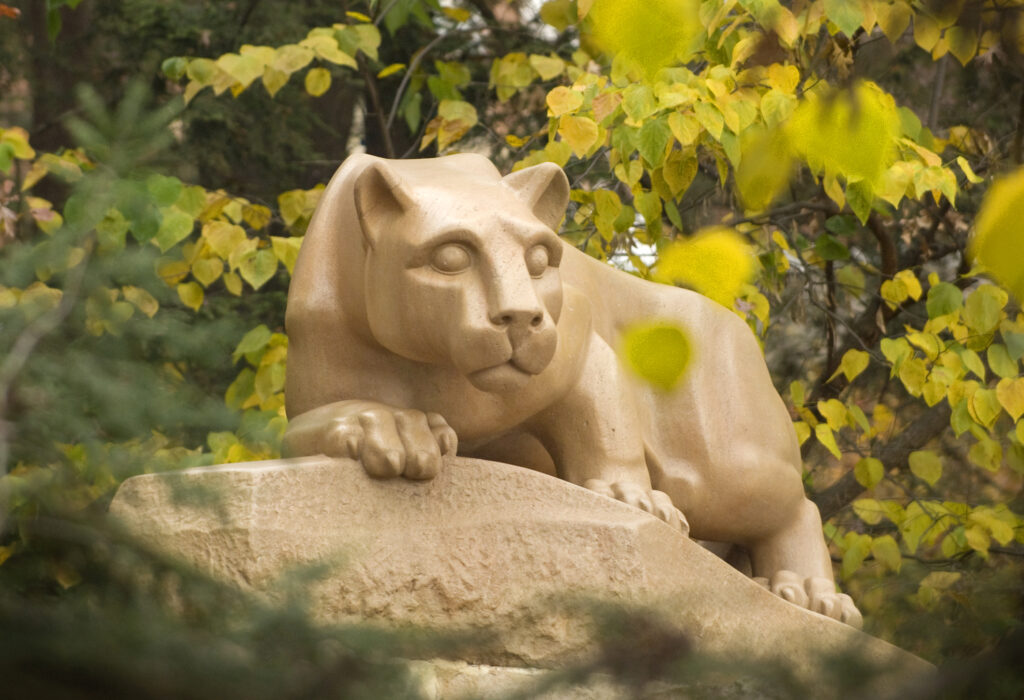The embodiment of the Penn State spirit for many is the statue of the Nittany Lion, situated in a small grove of trees to the east of Rec Hall. It is quite likely the most photographed place on the campus. Hundreds of thousands of students in caps and gowns at graduation, couples in wedding garb, and folks in family groups visiting the campus have posed for pictures on and around the Lion.
Today’s Nittany Lion Shrine can trace its roots to concerns surrounding the safety and location of football pep rallies. Well into the 1930s, there was no established spot for celebrations on campus. A 1938 bonfire at the corner of College and Allen Streets attended by 2,000 students did considerable damage to the brick streets and to many parking meters.
Seeing an opportunity, President Ralph Dorn Hetzel and student leaders began a campaign for a Nittany Lion Shrine where celebrations could be held on campus. The Class of 1940 adopted the project as its class gift. Noted sculptor Heinz Warneke was chosen to create the shrine to be located on a rise at the top of Burrows Road, between Rec Hall and New Beaver Field, at the then-center of Penn State’s athletic facilities. The Nittany Lion was sculpted there from a 13-ton block of Indiana limestone. As part of the contract, students could observe the process and ask questions as Warneke and his assistant worked.

At the dedication ceremony on October 24, 1942, Harrison “Joe” Mason, a 1907 graduate, spoke on the impromptu origins of the Nittany Lion mascot. Mason, who had invented the idea of the mascot on a baseball team trip to Princeton University, called the statue “an inspiration to every loyal son and daughter of Old Penn State for generations to come.”
Several traditions surrounding the Lion statue have developed, but none is better known than the homecoming ritual of guarding the Lion overnight, following the parade until the next day’s football game. This stemmed from the occasional vandalism by visiting-team fans throwing paint in their school colors on the Lion. Guarding the Lion had been an off-and-on affair in the second half of the twentieth century, but in the last thirty years, it has become a much more organized celebration with food, drink, and even, on occasion, a disc jockey providing music.
One of the most famous indignities to befall the Lion occurred in 1966 when student spirit was at a low and Syracuse orange was discovered painted on the statue before the big game. It roused the students and football team to an impressive fury. Years later, it was revealed that, in fact, Sue Paterno and two other coaches’ wives had painted the Lion with washable orange paint in the dead of night to stir up student passion. However, later in the week, during the wee hours of the morning, Syracuse students completely covered the Lion in orange paint and were arrested.
Real damage was done in 1978, when a vandal used a sledgehammer to break off the Lion’s right ear. The sculpture had never suffered such damage before or since. Warneke returned to campus to make a clay reproduction of the ear for an assistant to carve in stone and permanently affix to the Lion. After this, a full reproduction of the Lion was made for future needs and smaller reproductions were created for display at Penn State branch campuses.
Over the years, the setting has been enhanced with an enlarged stone base and approach, as well as lighting for evening viewing. The Lion statue and its surroundings have come to represent the “shrine” Hetzel and the students of earlier days envisioned. Even as most Penn State athletic contests have moved east to the other end of Curtin Road, Beaver Stadium is adorned with a replica of the Lion in the form of a weathervane atop the southwest corner of the stands and the Lion’s silhouette is placed on a massive screen on the ramp that ascends that corner of the stadium, both looking back in honor and respect to Warneke’s sculpture.
Lee Stout
Sources:
Jackie R. Esposito and Steven L. Herb, The Nittany Lion, An Illustrated Tale. University Park: Penn State University Press, 1997.
Lou Prato, 100 Things Penn State Fans Should Know & Do Before They Die. Chicago: Triumph Books, 2015.
Lee Stout and Harry H. West, The Lair of the Lion, A History of Beaver Stadium. University Park: Penn State University Press, 2019.
First Published: September 16, 2021
Last Modified: May 16, 2025
